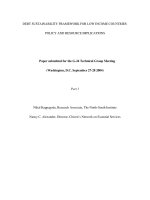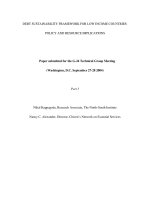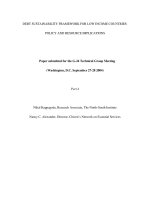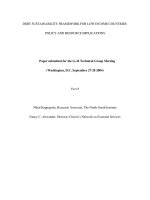DEBT SUSTAINABILITY FRAMEWORK FOR LOW INCOME COUNTRIES : POLICY AND RESOURCE IMPLICATIONS - Part 4
Bạn đang xem bản rút gọn của tài liệu. Xem và tải ngay bản đầy đủ của tài liệu tại đây (48.9 KB, 8 trang )
DEBT SUSTAINABILITY FRAMEWORK FOR LOW INCOME COUNTRIES:
POLICY AND RESOURCE IMPLICATIONS
Paper submitted for the G-24 Technical Group Meeting
(Washington, D.C. September 27-28 2004)
Part 4
Nihal Kappagoda, Research Associate, The North-South Institute
Nancy C. Alexander, Director, Citizen’s Network on Essential Services
Performance Based Allocation System
1
1. Every year, the World Bank rates the economic, social and political
performance of each borrowing government by the extent of its
compliance with its own definition of “good” policies and institutions.
For this purpose, it uses the CPIA. It rates the policy and institutional
performance of each government relative to 20 criteria (grouped in four
clusters). The World Bank uses this rating of individual governments as
a diagnostic tool to a) allocate loan and grant resources among
borrowers, b) determine the policy direction of new operations, and c)
influence debt threshold targets.
2. World Bank staff uses a formula to divide up the funds available for
low-income countries that includes “need” (income per capita) and
“performance.” For the fiscal years 2003 to 2005, the Bank made
resource allocations that were nearly five times higher for the
governments in the top-performing quintile than for those in the
poorest-performing quintile.
3. The CPIA rates countries primarily on the basis of current performance
in relation to twenty, equally-weighted criteria
2
,
3
that are grouped into
four clusters, namely:
1
This section draws on the article by Nancy Alexander of the Citizen’s Network on Essential Services
entitled “Judge and Jury: The World Bank’s Scorecard for Borrowing Governments”.
2
Please see Annex 2 for a full description of the criteria used and the CPIA for 2003.
• Economic management, including management of inflation
and the current account; fiscal policy; management of external debt;
and management and sustainability of the development program;
• Structural policies, including trade policy and foreign
exchange regime; financial stability and depth; banking sector
efficiency and resource mobilization; competitive environment for
the private sector; factor and product markets; and policies and
institutions for environmental sustainability;
• Policies for social inclusion, including gender equity and
equality of economic opportunity, equity of public resource use,
building human resources, safety nets; and poverty monitoring and
analysis; and
• Public sector management and institutions, including
property rights and rule-based governance; quality of budgetary and
financial management; efficiency of revenue mobilization;
efficiency of public expenditures; and transparency, accountability,
and corruption in the public sector.
4. Country performance is judged on the rating assigned to the criteria in
the policy clusters, governance and portfolio performance. According
to the Bank, the purpose of the CPIA is to measure a country’s policy
and institutional development framework for poverty reduction,
sustainable growth and effective use of development assistance. The
3
Based on the recommendations of the External Review Panel for the CPIA the World Bank is designing a
new format that groups 15 criteria into four clusters. The revised format will be reviewed by the Board of
the World Bank in September 2004.
CPIA rates the extent to which a government has adopted market
friendly economic policies such as liberalization and privatization in the
context of strict budget discipline and developed institutions,
particularly those that protect property rights and promote a business-
friendly environment.
5. What constitutes good policies and institutions is subjective and their
impact on growth not clear cut. Consequently, the use of CPIAs for
allocating aid resources and favouring better performers is contentious.
For example, a recent article by Easterly et al
4
casts doubt on the
proposition that aid promotes growth in countries with sound policies.
It further suggests that research is required to determine whether aid can
promote policy change and institutional reform and whether these in
fact can promote economic growth.
6. As stated, the World Bank allocates funds for low-income countries
taking into account both “need” and “performance.” The CPIA is an
important input in calculating a country’s performance rating. In order
to establish a government’s overall performance ratings (i.e. the IDA
Country Performance (ICP) Rating), the Bank aims to ensure that scores
are consistent within each, and across all, regions in performing the
following calculations:
4
“Aid, Policies and Growth: Comment” by William Easterly, Ross Levine and David Roodman, American
Economic Review 94:3, June 2004.
a. The CPIA (comprised of the four clusters listed in paragraph 37)
accounts for 80 percent of a country’s rating;
b.
The Bank rates each government’s performance on the portfolio of
outstanding loans. This rating accounts for 20 percent of a country’s
overall rating. It measures how well a government manages its loan
funds, including how well it achieves timely disbursement through
efficient procurement practices; and
c.
The level of grants and loans to which a borrowing government has
access will increase or decrease as a result of the Bank’s application of
a “governance factor” to the government’s CPIA and portfolio
performance ratings.
5
Each country’s “governance factor” is derived
from selected ratings, including the quality of its overall development
program and public sector management and institutions.
Chart
5
The methodology involves finding a weighted average of the CPIA score (which counts for 80 percent of
the rating) and the portfolio performance score (which counts for 20 percent) and multiplying the result by
the “governance factor” to produce the country’s IDA Performance Rating.









